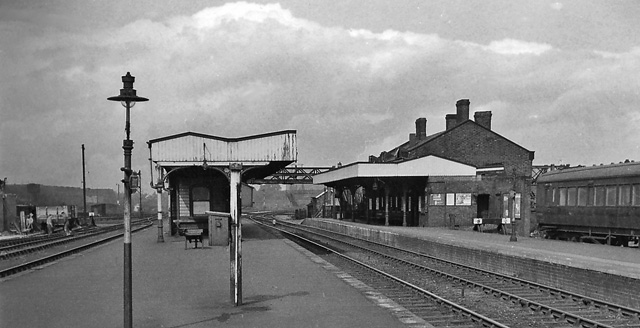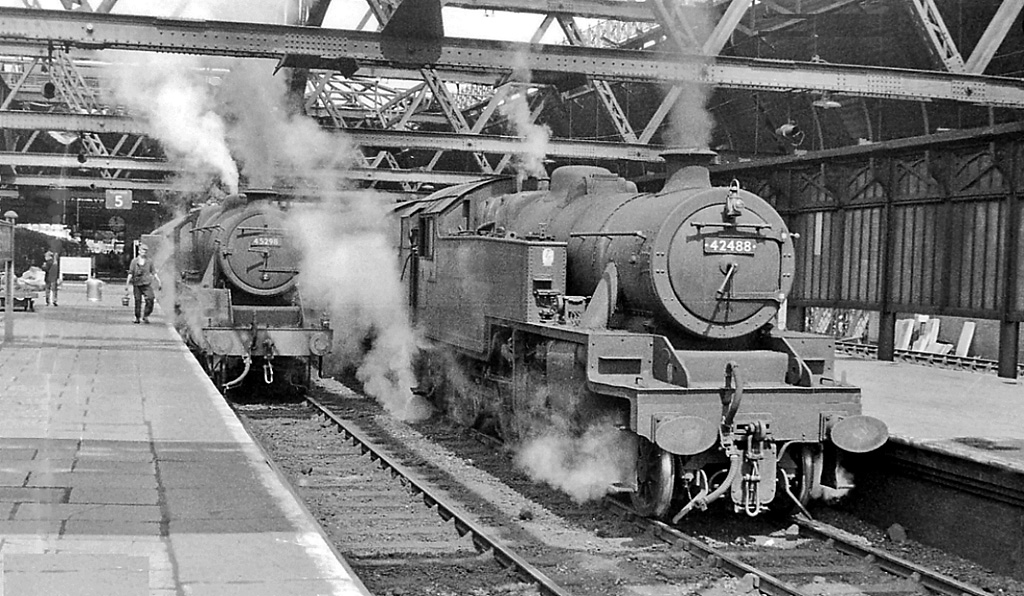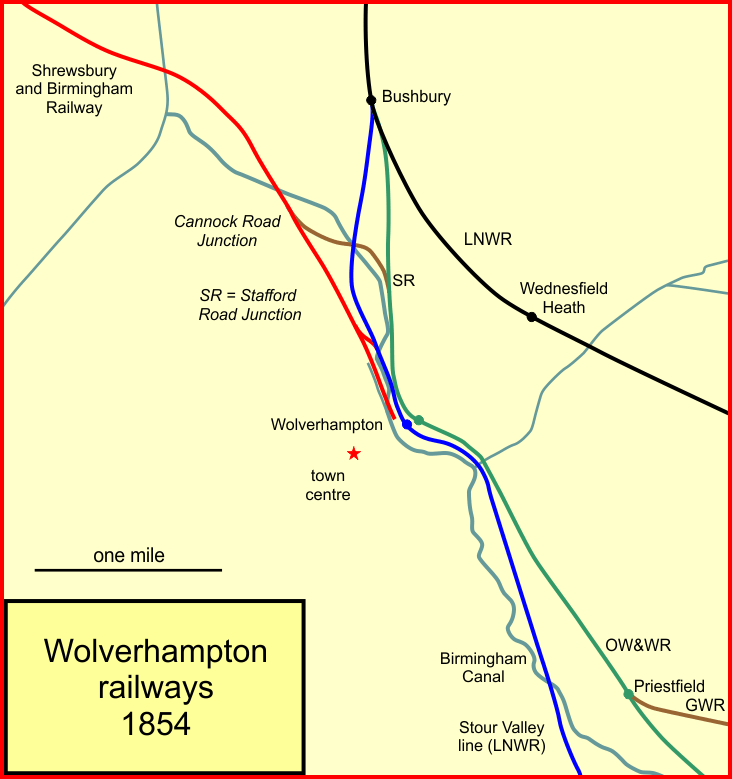|
Bescot Stadium Railway Station
Bescot Stadium railway station serves the Bescot area of Walsall in the West Midlands of England. (The station is located in the borough of Sandwell, although it can only be reached from within the borough of Walsall.) The station, and most trains serving it are operated by West Midlands Railway with some services being operated by London Northwestern Railway. History An earlier station was opened nearby as ''Bescot Bridge'' in 1837 by the Grand Junction Railway but was later renamed . A station was subsequently opened as Bescot on the current site on 1 May 1850, it was renamed to Bescot Junction in August 1850. The line through the station was electrified in 1966 as part of the London Midland Region's electrification programme. The actual energization of the line from Coventry to Walsall through Aston took place on 15 August 1966. It was renamed ''Bescot Stadium'' in 1990 in order to serve Bescot Stadium, the newly built home of Walsall Football Club. The station was r ... [...More Info...] [...Related Items...] OR: [Wikipedia] [Google] [Baidu] |
Bescot
Bescot is an area of Walsall in the West Midlands of England. It is served by Bescot Stadium railway station, adjacent to which is Bescot depot where locomotives are maintained. The Banks's Stadium was built in 1990 for Walsall F.C. The area is bisected by the M6 motorway, including its 'Junction 9', where it meets the A461 which leads to Pleck and Wednesbury. The River Tame also runs through the area. History Bescot was mentioned in the Domesday Book of 1086 as a carucate of waste land in the possession of the King. It was mentioned in other ancient writings under the name of 'Berkenscot' and 'Bresmundscote'. An ancient manor house was then constructed before 1311 in the area and first possessed by the Hillary family. In 1403, Sir Roger Hillary died and the manor was passed on to the possession of his wife, Margaret. When she died, the property was passed on to Sir John Saer de Rochford, Roger's nephew. It later passed into the possession of the Mountfort family. In 1460, th ... [...More Info...] [...Related Items...] OR: [Wikipedia] [Google] [Baidu] |
Bescot Stadium
Bescot Stadium, also known as the Poundland Bescot Stadium for sponsorship purposes, is a football stadium in Walsall, England, and the current home ground of Walsall Football Club. It was built in 1989–90, by GMI Construction, with a reported build cost of £4.5m. The stadium replaced the club's previous ground, Fellows Park, which was located a quarter of a mile away and was the club's home for 94 years. History Following the takeover of Walsall FC by Terry Ramsden in 1986, plans were drawn up for the club to move from its antiquated Fellows Park stadium to a new site in the town. In 1988, a site at Bescot Crescent was identified as the location for a new stadium, and work began on the new stadium in 1989 with completion targeted for the start of the 1990–91 season. The stadium was opened on 18 August 1990, by Sir Stanley Matthews, prior to a friendly match with neighbours Aston Villa in front of 9,551 spectators. Aston Villa won the match 4–0. The first competitive g ... [...More Info...] [...Related Items...] OR: [Wikipedia] [Google] [Baidu] |
British Rail Class 170
The British Rail Class 170 ''Turbostar'' is a British diesel multiple unit (DMU) passenger train built by Adtranz and later Bombardier Transportation at Derby Litchurch Lane Works. Introduced after privatisation, these trains operate regional as well as long-distance services, and to a lesser extent suburban services. A total of 139 units were built, but some were later converted to and units. These trains are currently in use with West Midlands Trains (formerly London Midland), CrossCountry, East Midlands Railway, Transport for Wales Rail, ScotRail and Northern Trains. Design The class is a development of the design used in the British Rail Class 165 and 166 DMUs known as the ''Networker Turbos'' and built by British Rail Engineering Limited and later ABB Transportation Ltd before that company became part of Bombardier. Notable features shared are the aluminium alloy frame and Voith transmission as well as the general body shape (the cab ends are similar to those of the ... [...More Info...] [...Related Items...] OR: [Wikipedia] [Google] [Baidu] |
British Rail Class 323
The British Rail Class 323 are electric multiple unit (EMU) passenger trains built by Hunslet Transportation Projects and Holec. All 43 units were built from 1992 through to 1995, although mock-ups and prototypes were built and tested in 1990 and 1991. Entering service in 1994, the 323s were among the last trains to enter service with British Rail before its privatisation in the mid-1990s. The units were designed to operate on inner-suburban commuter lines in and around Birmingham and Manchester with swift acceleration and high reliability. Of the 43 sets built, 26 are in operation with West Midlands Trains and 17 with Northern Trains. In 2023 the West Midlands Trains sets will start to be replaced by new Class 730 EMUs, and 34 sets will be operated by Northern Trains. The units are known for the distinctive sounds that can be heard during acceleration or deceleration. These sounds are generated by the traction electronics. Background In 1990 the Regional Railways sector of ... [...More Info...] [...Related Items...] OR: [Wikipedia] [Google] [Baidu] |
British Rail Class 350
The British Rail Class 350 is a class of electric multiple-unit built by Siemens Transportation Systems to its Siemens Desiro, Desiro design between 2004 and 2014. All 87 are now operated by West Midlands Trains, having previously been operated by Central Trains, Silverlink, Southern (Govia Thameslink Railway), Southern, London Midland, First TransPennine Express and TransPennine Express. Description The Class 350/1 units were originally part of an order for 32 five-car units for South West Trains. However, they were never built as such. Of the 160 carriages ordered, 40 were diverted as an additional 10 four-car Class 450 units, and the remaining 120 were modified as 30 four-car Class 350/1 units. These entered service in 2005 and were used jointly by Central Trains and Silverlink, both owned by National Express. The top speed of the fleet was originally , but all 350/1s were modified to allow running from December 2012, in order to make better use of paths on the busy West Co ... [...More Info...] [...Related Items...] OR: [Wikipedia] [Google] [Baidu] |
Rugeley Trent Valley Railway Station
Rugeley Trent Valley is a railway station located on the outskirts of Rugeley in Staffordshire, England. It is one of two stations serving Rugeley, the other being Rugeley Town. It is on the eastern side of the town close to the Rugeley Trent Valley Trading Estate and located close to the River Trent. West Midlands Trains operate the station, and all trains serving it. It is a minor station on the Trent Valley section of the West Coast Main Line. It is also the junction with the Chase Line from Birmingham and Walsall. History The main line had opened back in September 1847 and the station along with it. The line from was added by the Cannock Mineral Railway in 1859. On 25 May 1998 the Chase Line was extended back into Rugeley Trent Valley from and . Services had previously been withdrawn in January 1965, as a result of the Beeching cuts. From the mid-1960s until 1998, it was served only by local stopping trains between Stafford and either Rugby or (from 1987) – these w ... [...More Info...] [...Related Items...] OR: [Wikipedia] [Google] [Baidu] |
Shrewsbury Railway Station
Shrewsbury railway station is in Shrewsbury, Shropshire, England. Built in 1848, it was designated a grade II listed building in 1969. The station is north west of Birmingham New Street. Many services starting at or passing through the station are bound for Wales; it is operated by Transport for Wales, although the station is also served by Avanti West Coast and West Midlands Railway services, and is one of the key network hubs of Transport for Wales. History The station was formerly known as Shrewsbury General and is the only remaining railway station in the town; Shrewsbury Abbey, as well as other small stations around the town, having long closed. Shrewsbury railway station was originally built in October 1848 for the county's first railway — the Shrewsbury to Chester Line. The architect was Thomas Mainwaring Penson of Oswestry. The building is unusual, in that the station was extended between 1899 and 1903 by the construction of a new floor underneath the original st ... [...More Info...] [...Related Items...] OR: [Wikipedia] [Google] [Baidu] |
Wolverhampton Railway Station
Wolverhampton railway station in Wolverhampton, West Midlands, England is on the Birmingham Loop of the West Coast Main Line. It is served by Avanti West Coast, CrossCountry, Transport for Wales and West Midlands Trains services, and was historically known as Wolverhampton High Level. History The first station named ''Wolverhampton'' had opened on the edge of the town centre in 1837 on the Grand Junction Railway, this station was renamed Wednesfield Heath in 1855, shortly after the present station was opened, and then was closed in 1873. On 12 November 1849, the Shrewsbury and Birmingham Railway opened a temporary terminus to its line, at a location very close to the present station. The present station was opened on 1 July 1852 by the Birmingham, Wolverhampton and Stour Valley Railway, a subsidiary of the London and North Western Railway (LNWR); it was named ''Wolverhampton Queen Street''. The only visible remnant of the original station is the Queen's Building, the ga ... [...More Info...] [...Related Items...] OR: [Wikipedia] [Google] [Baidu] |
Euston Railway Station
Euston railway station ( ; also known as London Euston) is a central London railway terminus in the London Borough of Camden, managed by Network Rail. It is the southern terminus of the West Coast Main Line, the UK's busiest inter-city railway. Euston is the eleventh-busiest station in Britain and the country's busiest inter-city passenger terminal, being the gateway from London to the West Midlands, North West England, North Wales and Scotland. Intercity express passenger services are operated by Avanti West Coast and overnight services to Scotland are provided by the Caledonian Sleeper. London Northwestern Railway and London Overground provide regional and commuter services. Trains run from Euston to the major cities of Birmingham, Manchester, Liverpool, Glasgow and Edinburgh. It is also the mainline station for services to and through to for connecting ferries to Dublin. Local suburban services from Euston are run by London Overground via the Watford DC Line which runs ... [...More Info...] [...Related Items...] OR: [Wikipedia] [Google] [Baidu] |
Walsall Railway Station
Walsall railway station is the principal railway station of Walsall, West Midlands, England and situated in the heart of the town. It is operated by West Midlands Trains, with services provided by West Midlands Railway and from 2019, London Northwestern Railway operate a service from Rugeley to London Euston that calls at the station. The main entrance is situated inside the Saddlers Shopping Centre. Overview Services from the station go to Birmingham New Street south on the Walsall Line, (operated on behalf of Transport for West Midlands), and north to Cannock and Rugeley. The station has three platforms: *Platform 1: operating northbound services to Rugeley; *Platform 2: operating southbound, semi-fast services from Rugeley to Birmingham New Street; *Platform 3: (a terminus platform) operating local services to Wolverhampton via Birmingham New Street. Platforms 2 and 3 have been recently refurbished, with a new waiting room added and poems on the walls of the stairs to ... [...More Info...] [...Related Items...] OR: [Wikipedia] [Google] [Baidu] |
Birmingham New Street Railway Station
Birmingham New Street is the largest and busiest of the three main railway stations in Birmingham city centre, England, and a central hub of the British railway system. It is a major destination for Avanti West Coast services from , and via the West Coast Main Line, the CrossCountry network, and for local and suburban services within the West Midlands; this includes those on the Cross-City Line between , and , and the Chase Line to and . The three-letter station code is BHM. The station is named after New Street, which runs parallel to the station, although the station has never had a direct entrance except via the Grand Central shopping centre. Historically, the main entrance to the station was on Stephenson Street, just off New Street. As of 2022, the station has entrances on Stephenson Street, Smallbrook Queensway, Hill Street and Navigation Street. New Street is the fifth busiest railway station in the UK and the busiest outside London, with 46.5 million passenger ... [...More Info...] [...Related Items...] OR: [Wikipedia] [Google] [Baidu] |
Chase Line
The Chase Line is a suburban railway line in the West Midlands region of England. It runs from its southern terminus, Birmingham New Street, to Walsall, and then Rugeley in Staffordshire, where it joins the Trent Valley Line. The name of the line refers to Cannock Chase which it runs through at its northern end. Part of the line, between Birmingham and Walsall, has been electrified since the 1960s; work to electrify the remaining 15 mile stretch of line between Walsall and Rugeley, was completed in December 2018. History *The line from Birmingham via Aston, Perry Barr and Bescot was opened in 1837 as part of one of the earliest railway main lines; the Grand Junction Railway (GJR). This line did not serve Walsall directly, but continued from Bescot to Wolverhampton (this is now part of the Walsall to Wolverhampton Line). A station on the GJR called ''Walsall'' was opened on the outskirts of the town, this was later renamed , and is now closed. The GJR became part of the London an ... [...More Info...] [...Related Items...] OR: [Wikipedia] [Google] [Baidu] |







.jpg)
